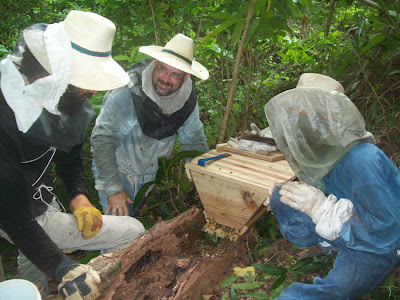Top-Bar Beekeeping 101: post assignment thoughts
 |
| Excitement as the bees march into the top bar hive |
The main interest among most Jamaican beekeepers for top bar hives (tbh) is the increased wax production. Bees wax cannot be imported into Jamaica. The government wants no further bee diseases to enter the country, especially something like colony collapse disorder. Obtaining the necessary wax is difficult for the new beekeepers and those who want to expand their operations.
The top bar beekeeping system requires very little wax to get the bees started in their boxes but yields much more, since harvesting is done by cutting off the comb, crushing it and straining out the honey. More wax is generated this way than the normal movable frame system, where comb is not destroyed so that it can be returned to the bee hive.
 |
| Honey for sale in the streets of Jamaica |
The economic problems in Jamaica and the difficulties beekeepers and people in general face are the same that I see in Honduras. It is something I live and deal with every day. Simply buying everything is not an option. You must always consider different ways to do something—using alternative materials and making equipment oneself.
I was helping to set up the top bar hives at Yerba Buena Farm in St. Mary as part of a model apiary that will eventually be used to train beekeepers in the top bar hive system. As part of this, I wanted to incorporate as many options and as much appropriate technology equipment so beekeepers can see that there are different ways to get started in beekeeping. You don't have to spend lots of money and buy everything—much of the equipment can easily be made.
We incorporated four types of hives into the apiary at this organic farm. There is the standard movable-frame Langstroth hive which most beekeepers use. But there are also three types of top bar hives made with different materials: solid wood, a type of hardboard and bamboo. Each one is progressively less expensive.
The bamboo hive, dubbed the "Rasta Hive", is probably my favorite because of its cost, which is very low. Bamboo was something that I always wanted to experiment with but it's not readily available in my part of Honduras. This was my chance. Bamboo is located all over the island and has become too invasive. Projects are actually underway to eliminate bamboo forests and replant with hardwood trees.
 |
| Tying the brood comb to a top bar |
Another project we made during my month was a pollen trap that fits on a top bar hive. The problem here was finding the right size material for the entrance screen. You need to import it since beekeepers can't find it in Jamaica. As the bees enter the hive, they pass through a screen which scrapes the pollen balls off their legs. The solution was to use a simple piece of tin with the correct size holes punched or drilled into it, which would remove the pollen pellet.
Other equipment projects included simple veils, gloves, smokers, queen cages and a wax foundation mold.
 So we hung trap hives and removed wild colonies—free bees.
Eventhough it was not the prime swarming season, we did manage to capture one
swarm. We suspect, however, that it may have been the colony that decided it didn't
like being removed from its termite nest and getting transferred into a tbh. At
least it demonstrated that they should work. About 80 percent of the colony
transfers were successful, however.
So we hung trap hives and removed wild colonies—free bees.
Eventhough it was not the prime swarming season, we did manage to capture one
swarm. We suspect, however, that it may have been the colony that decided it didn't
like being removed from its termite nest and getting transferred into a tbh. At
least it demonstrated that they should work. About 80 percent of the colony
transfers were successful, however.The project has removed about 12 wild colonies so far to begin establishing the apiaries. There are probably at least that many more that can be removed. People were constantly coming forward to say where they have seen colonies. There seems to be a very healthy population of bees in the bush—an indication of the state of bees in general in Jamaica.
 |
| Removing a wild bee colony from a termite nest |
Tom's Beesource posts: Beekeeping in Jamaica
Dee's blog: Dee Lee's Bees
Erin's Blog: Jamaican Bees!
Tom Hebert, originally from Wisconsin, has been living in Honduras for more than 20 years where he manages 75 top bar hives in addition to teaching English in a bilingual school. This was his first Farmer to Farmer assignment.




.png)

Very interesting! Thank you for sharing!
ReplyDelete